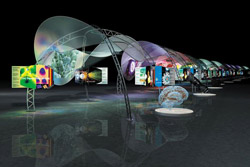The Science Tunnel in Florida

The Science Tunnel - A Journey Through Scientific Discovery
On January 16, 2009, the internationally-renowned Science Tunnel, an exhibition of the Max Planck Society, makes its U.S. debut at the South Florida Science Museum. Bank of America is the presenting sponsor of the exhibition that runs for 10 weeks though March 29, 2009, inside a 10,000-square-foot tent on the grounds of the Museum in West Palm Beach, Fla.
The Science Tunnel, a sophisticated, interactive multimedia exhibition, offers visitors a fascinating trip into the realm of scientific discoveries. The special exhibition features video stations and hands-on exhibits designed to spark interest in science and a deeper understanding of science research among even the youngest minds. Visitors can observe dancing atoms and molecules at work; discover the roots of human culture; fight a virus before it infects the body; or race through the city of Tübingen, Germany on a bicycle at the speed of light.
Debuted in Ludwigshafen, Germany in 2005, the Science Tunnel has traveled to some of the great cities of the world including Tokyo; Singapore; Shanghai; Brussels; Johannesburg; Seoul; and Berlin. Palm Beach County, Fla. – home to the new Max Planck Florida Institute – is its first U.S. location. In other cities, the exhibit has attracted a range of 50,000 to 170,000 visitors, including students and school groups, during its exhibition period. There are already more than 30 school groups from St. Lucie, Palm Beach and Broward counties scheduled to tour the Science Tunnel, including more than 250 students on opening day from Watson B. Duncan Middle School in Palm Beach Gardens, and Coral Reef Elementary and Planet Kids in Lake Worth.
The Science Tunnel has a dramatic entrance, exit and 12 themed modules that showcase topics such as “On the way to the Big Bang;” “From gene to organism;” “Technologies of the future;” and “Spaceship Earth.” The Science Tunnel weighs approximately 25 tons, takes 12 days to erect and includes 16 video projectors, 13 monitors, 26 DVD units, 8 AMX media control units and 14 sound systems.
Most of the unique pictures, videos, computer simulations and exhibits within the Science Tunnel come from the 80 Max Planck institutes in Germany and abroad. CERN, the world's largest particle physics laboratory, the European Space Agency (ESA), the European Southern Observatory (ESO), the Fraunhofer Society and other institutions have also loaned valuable components.
A dynamic lecture series is part of the special exhibition that opens on January 16 at 11:00 a.m. in the Elsie Dekelboum Motorola Theater with a talk by Prof. Dr. Alexander Borst, Director of the Max Planck Institute of Neurobiology in Martinsried, Germany. A member of some of Europe's most prestigious scientific organizations, including the Otto Loewi Center in Israel and the German-based Alexander von Humboldt Foundation, Dr. Borst will discuss his work with brain imaging, followed by a question and answer session led by the Museum's Dr. Laura Sessions. More than 75 science magnet students from Palm Beach Gardens High School are expected to attend. Additional lecture dates and speakers will soon be announced.
Admission is $15 for adults and $10 for children ages three to 12. Prices include access to the South Florida Science Museum. The Museum is located at 4801 Dreher Trail North in West Palm Beach, Florida, and is open seven days a week. Exhibition times may vary, contact 561.832.1988 and www.sfsm.org for more information.
Media Contact
All latest news from the category: Science Education
Newest articles

Bringing bio-inspired robots to life
Nebraska researcher Eric Markvicka gets NSF CAREER Award to pursue manufacture of novel materials for soft robotics and stretchable electronics. Engineers are increasingly eager to develop robots that mimic the…

Bella moths use poison to attract mates
Scientists are closer to finding out how. Pyrrolizidine alkaloids are as bitter and toxic as they are hard to pronounce. They’re produced by several different types of plants and are…

AI tool creates ‘synthetic’ images of cells
…for enhanced microscopy analysis. Observing individual cells through microscopes can reveal a range of important cell biological phenomena that frequently play a role in human diseases, but the process of…





















